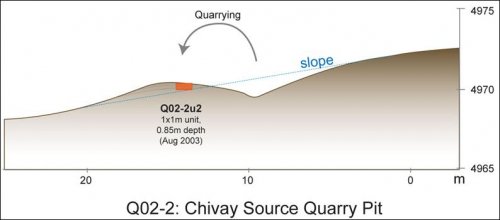Testing in the debris pile in 2003
In the course of the 2003 Upper Colca Project a 1x1m test unit was placed at Q02-2 in the debris pile immediately downslope of the quarry pit. The unit was aligned to true north and placed on the uphill side of the summit of the debris pile with the aim of bisecting the widest range sizes of pre-existing debris piles as the pile had accumulated below the quarry during ancient use. In the course of the test excavation, the team avoided filling the quarry pit feature with soil or other materials and instead positioned the backdirt piles and screened dirt on the south-east end of the quarry feature.
Figure 7-7. Diagram of Q02-2 quarry pit and position of the Q02-2u2 test unit relative to quarry debris layers and natural slope. By virtue of the quarrying history, levels are inverted in the 1x1m test unit so upper levels came from lower (earlier) levels in the quarry pit.
The quarry pit debris pile included relatively few culturally modified artifacts. While thousands of obsidian "flakes" with conchoidal fracture were encountered, closer inspection revealed that a very small minority were fractured by the human hand. Cortex is sometimes very thin on many of the flakes and nodules at the Chivay source (Section 4.5.1), which complicated the task of differentiating cultural and non-cultural flakes. Non-cultural flakes had no clear bulb or striking platform, or the geometry of the bulb was such that the force responsible for fracturing the rock was evidently far away and was geological in scale. In other words, one would see bulbs of percussion that appeared to have been initiated on adjacent rocks by geological or environmental processes, and the force of the fracture transferred through the obsidian matrix.
Figure 7-8. Q02-2, view of quarry pit and u2 test unit from the north.


